#Shiva Wall Painting
Explore tagged Tumblr posts
Text
In Indian houses, there are huge significances of hanging wall paintings especially Religious and of Indian gods & Goddesses. These wall paintings such as Lord Krishna Paintings bring calm, peace, and a lot of positive energy to home. Along with this, wall paintings can also enhance the overall appearance and interiors of your home.
#Lord Krishna Paintings#Canvas Painting For Living Room#Shiva Wall Painting#Buddha Wall Painting#Ganesha Wall Painting
0 notes
Text
In the Dirt

Synopsis: Robby reflects on the loses and not just the ones that end up six feet under.
Pair: Dr Michael Robinavitch/You
Rating: PG13
Warning: Angst
Word Count: 1139
A/N: You can thank @darcylightninglewis for this. I was helping her figure something out and uh this happened. Based off this song.
----
Home state, old paint Used to shine, now it don't look the same
Robby looked at the mail. It was from the shul his grandmother would take him to, reminding him her yahrzeit was coming up.
He doesn't know why he still pays the shul's dues. He hasn't gone since his grandmother's funeral. Then again, he still lives in the brownstone she raised him in.
He rented it out when down in New Orleans but he couldn't bring himself to sell it. Not when the walls held her memory.
But it wasn't just her memory that lived in these walls.
—
I take a drink and I let it burn 'Cause there's a part of me that likes the way it stings, the way it hurts
You had been by his side as his grandmother slipped more and more away. Even taking care of her when Robby was away at medical school.
You called him when it was time.
Now you sat with him as people stopped by with food and their condolences. Robby didn't want any of it; he wanted to get back to work but his grandmother's last words filled his head.
"You better sit Shiva for me, then," she took his hand. "You propose to that girl, not many would do what she has."
Robby looked over at you. He knew you wouldn't leave Pittsburgh but he knew you would wait.
—
Wasted all my lies on the four walls that I'd known And I'm scared of what's to come more than I fear being alone.
"No, Michael." You say packing your bag. "I'm not going to stay if you're just going to work the whole time."
Robby just watched you. "I don't know what you want from me."
You turned to him. "I want you to give a damn Michael. I want you to leave work at work like a normal person and take days off."
"You knew what you were getting into-"
"Bullshit!" You yell. "I was marrying the boy I fell in love with who wants to save people and be there for those he loves."
Robby just shrugs and goes to fix his bag for work tomorrow.
You stare at his back fighting back the burn building behind your eyes. "So that's it? You aren't going to fight for us?"
"It seems you made up your mind." He turns to you. Part of him is screaming for you to keep calling out his bullshit, to keep pushing him. But then he sees it in your face.
He expected you to wait for him, when he couldn't even clearly let you in on the pain building in his chest. A pain that has been getting worse since his grandmother's Shiva.
'Cause every time it's going right I'm left here on my own.
—
It don't talk to God, don't think it works 'Cause I know better people than myself still end up in the dirt
The day Adamson dies, he looks you up. Sees all the good you're doing, even became a mom.
He's tempted to call you. To cry his pain to you. But then he remembers getting the wedding invitation and RSVPing 'no' without a second thought. Even through you told him, it would be great to see him. Though he knew that marriage hadn't lasted for long; cancer never cared about anyone.
He sighs and closes his eyes. The flashing of that moment he saw you at the hospital, how he had wanted to kiss you when he saw you. Then he realized you were there with your husband.
And he still kicked himself for what happened when he comforted you. Another reason he couldn't look at the little girl standing next to you in your social media posts.
He really should call you…
—
'Cause I know better people than myself still end up in the dirt.
He knocks on your door, closing his eyes as he hears you moving around.
"One moment!" you yell.
It had been 24 hours since PittFest and he still couldn't get everything that happened out of his mind. Especially not Jake's face.
And even now more than every, he wanted to have you forgive him. To get to know his little girl.
He opened his eyes when you opened the door. You were smiling but it dropped when you saw him. "Michael?"
As he went to say something, he heard little footsteps then a girl no older than 8 walks over and hug your waist. "Mama, who's that?"
His heart ached as he looked at the little girl, your's and his. Then he looked at you and your shoulders dropped seeing his face.
"Why don't you go finish cleaning up Rachel." The girl nodded then ran off again. "No running in the house!" You yell before looking at Michael.
"Rachel? You named her…" He rubbed at his chest as all the pain came crashing back.
"She was an important person in my life too, Michael." You whispered. "Why are you here?"
He sniffled and rolled his shoulders. "Yesterday was shit and I just couldn't think of someone who would even understand one moment about how much pain I'm in."
"PittFest was at your hospital?" You asked. You had seen the news but turned it off to not upset Rachel.
All Robby could do was nod before the tears started coming again. Before he knew how to react, you were hugging him. "Oh Michael."
He hugged you back and quietly cried into your shoulder.
You stroked his hair and let him cry. "I've got you."
—
In the dirt In the dirt
"So what brings you in today, Michael?" Robby rubbed his hands together looking at the man Jack had suggested for therapy.
"I need to be better for my daughter and her mother said that I need to go to therapy to do that." Robby nodded at the thought of Rachel, how he was lucky you were letting him anywhere near her. That she was even allowed to know who he really was to her. "That and uh Jack Abbot is usually a smart man and he suggested you as well."
The doctor nods. "Okay. What has them worried about you?"
Robby took a breath. "I'm aware enough to know that the people I've lost have greatly affected my abilities as an ER doctor," he sighed. "And I need to work on ways to cope with it all since it seems keeping people out is my only defense."
The doctor took a few notes and gave an encouraging smile to Robby. "Well Michael, this is a great first step. Now lets talk about how this all started."
He touched his Magen David and nodded. "Probably when I lost my grandmother, she raised me and I was left with just the walls of the brownstone she raised me in…"
#dr michael robinavitch#dr robby x you#michael robinavitch x you#the pitt hbo#the pitt fanfiction#song fic#the pitt#noah wyle character#sammi writes#SJ writes
33 notes
·
View notes
Photo
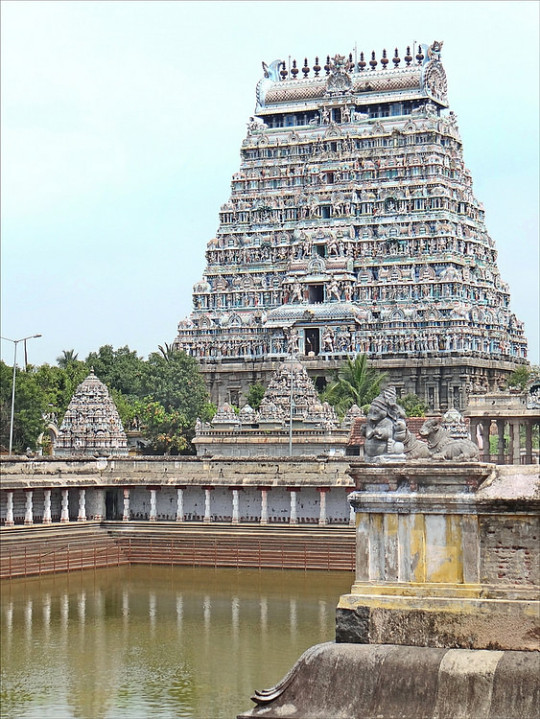
Chidambaram
Chidambaram (Cidambaram) is an important Chola temple site in Tamil Nadu, southern India. Most of the temples at Chidambaram were built in the 12th and 13th centuries CE. The site is dominated by the huge gateway tower of the Nataraja temple but Chidambaram also boasts the first Devi or Amman shrine, the first Surya shrine with the distinctive stone chariot wheels which would adorn many subsequent temples, and the first large Siva Ganga tank. In this respect Chidambaram is something of a transitional site, linking elements of the old and new styles of Indian temple architecture.
The name Chidambaram, one of several from antiquity, derives from the Tamil Cirrambalam, meaning 'little hall'. The site was chosen because according to mythology it was the precise spot where the Hindu god Shiva had once danced in a grove of tillai trees. The dance was, in fact, a competition between Shiva and Parvati and naturally the great Shiva won. The story became a popular subject in Hindu art over the centuries.
The site is enclosed within four perimeter walls and covers a rectangular area of 55 acres. Within the compound are shrines, halls, temples, ornamental gateways, and a large ritual bathing pool, known as a Siva Ganga tank, which is surrounded by cloisters. Inscriptions claim the site was built by various Pandya kings and local rulers but none are contemporary with the dates the buildings were actually first constructed. The walls and east gopura (gateway) may be ascribed with greater certainty, and were probably built by Kulottunga III, who reigned from 1178 to 1218 CE.
The Nataraja temple was constructed between c. 1175 and c. 1200 CE. The actual temple shrine is relatively modest as by now in Indian architecture the gopuras had become the most important structures, at least in terms of aesthetics. The twin sacred chamber was, however, adorned with copper sheets covered in gold by successive Chola kings. The shrine is preceded by a dance hall and large entrance porch with columns (mandapa).
The massive granite and brick east gopura dominates the site but there are three other gopuras on the north, south and west sides (the earliest). The corbelled roofs diminish as the structures rise and are finally topped with the usual barrel-vaulted roof (sala), the eastern gopura also having a row of 13 decorative finials. The east gopura has a proper interior floor at each of its nine levels and there is an interior staircase which climbs to the very top of the building. All four gopuras have false windows on their facades, typical for this kind of structure, and pairs of pilaster columns set at regular intervals. The second floor of each gopura also has a passageway which worshippers ritually walked around. The entrance archways all have coffered ceilings decorated with relief panels.
Of particular note at Chidambaram are the thousands of sculptures adorning its buildings. In particular there are many statues of women in a wide variety of dance postures. Many statues are accompanied by quotations from Hindu literature which provide an invaluable reference for scholars. There are also figures of the four dvarapalas (guardian demons), the dikpalas (cardinal directions), many figures of Shiva performing heroic deeds, various other deities such as Vishnu, Devi, Sarasvati, and, unusually in southern architecture, river goddesses.
Finally, Chidambaram is also famous for its 17th century CE Nayaka ceiling paintings which decorate the Shivakamasundari shrine of the Nataraja Temple. More than 40 panels depict scenes from the life of the saint Manikkavachakar, a devotee of Shiva.
Continue reading...
91 notes
·
View notes
Note
jpeg my beloved, i am here with ask game emojis! 🥤🍄🪐🏜️🪲
also to tell you that the pic of your puppy with painted nails is SO cute!!! humbly requesting puppy's name as well pls 🥺
🥤 ⇢ recommend an author or fanfic you love
searching faces by Take_Me_To_Your_Fragile_Dreams (Explicit, 76.8k words, 16/? chapters) is a work of fucking Art. primo outlaws content. incredible joker junior/tim characterization. its so angsty but also so hopeful. 10/10 would recommend
🍄 ⇢ share a head canon for one of your favourite ships or pairings
i'm not sure if this counts bc its not a ship thing, but as a pair, i am a twins!Jason&Cass truther. Jason who is dosed with a truth serum at some point but,,, it does nothing. He finds out he has a natural resistance to truth serum. a... Genetic predisposition. you know what's funny? Lady Shiva was dosed with serum when she told batman and robin she'd never had a kid (obviously this is because cass cain as a character didnt exist yet yada yada retcon yada yada WHATEVER i do what i want)
ANYWAY further genetic testing reveals that jason and cass are siblings. after shiva gets tracked down, she reveals that she had twins with David Cain, but he only wanted one kid to experiment on. he took cass because, ironically, jason was the runt. shiva drops jason on Willis Todd, former associate (romantic? sexual? criminal? personal? whose to say)
Catherine, who decided not to have bio kids because she didnt want to pass on a genetic disease that caused many of her family to die young (*jaws theme song*), went '🥺 free baby? can we keep him? 🥺' and the rest is history
Jason's whole world is rocked when he discovers this. Cass is like '??? you are Already brother.' and jason is like 'ITS DIFFERENT' and cass is like 'incorrect.' despite finding out they are twins, cass relentlessly refers to him as baby brother.
🪐 ⇢ name three good things going on in your life right now
No debt 🤘
I've started collecting lego minifigures of batman characters and i love them <3
Currently planning a trip to nyc in december! i've never been!!
🏜️ ⇢ what's your favourite type of comment to receive on your work?
I love getting comments that really engage with me as a writer, e.g. asking questions about the story, predicting what will happen next, etc. I also LOVE getting off the walls bonkers shit. No greater compliment than someone being deranged about my work.
🪲 ⇢ add 50 words to your current wip and share the paragraph here
honestly, thank you, i really needed a little kick on this one. I added a couple paragraphs to the next chapter of Very Special Clone Boy which i am going to finish on GOD
Kon spared a moment to consider the civilians in the house behind him, the maybe-probably-not-but-possibly future in-laws he’d put in danger with nothing more than his general proximity. His soulmate who he’d put in danger. Maybe. Possibly. That, or just some randos who happened to have the same last name as his soulmate, which wasn’t really any better.
This is Finley, she's a 6 year old boston terrier, and I yearn to commit war crimes on her behalf.


#bean my beloved#this was so fun i love you#fic rec#jaytim#timkon#jpegs fic#jpegs puppy#jpegs snippet#very special clone boy#fic update#tmnoovscb
19 notes
·
View notes
Text
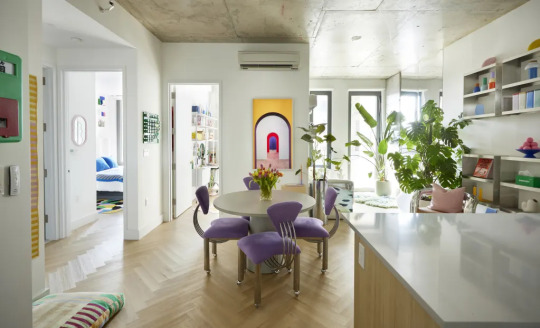











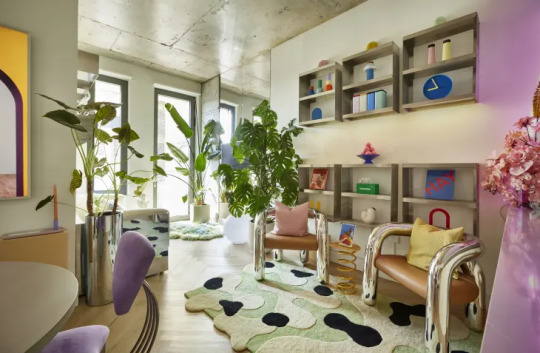
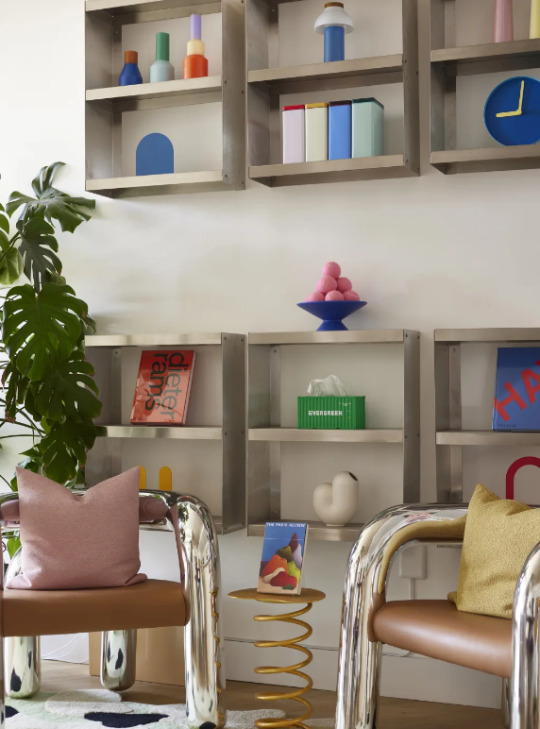
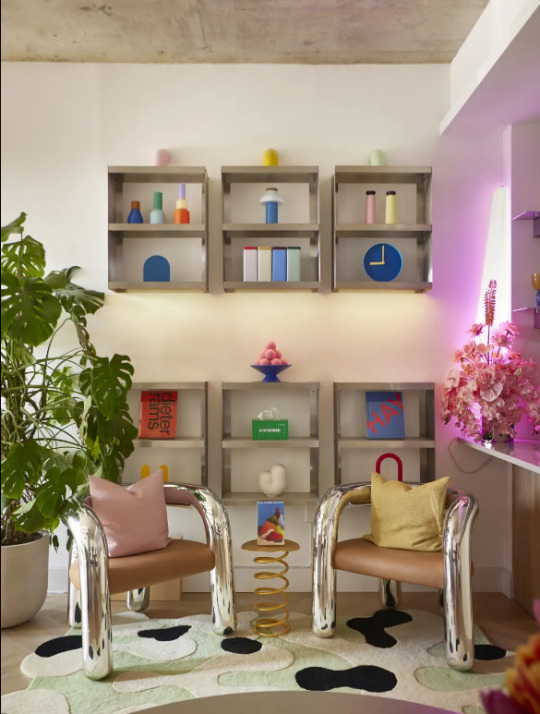

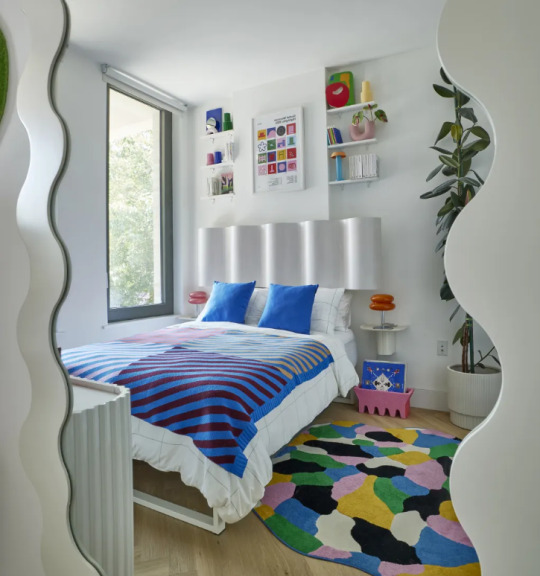

HOME TYPE: Apartment
LOCATION: Bushwick, Brooklyn, New York
STYLE: Colorful, Industrial, Maximalist
BEDROOMS: 2
SQ FT: 747
PAINT & COLORS:
All Rooms — Benjamin Moore “Bancroft White (DC-01)”
ENTRYWAY
Coat Rack — UTIL
Flowerpot — &Tradition
Taiwanese Mailbox — Yun Hai Selection
Small Rectangular Mirror — HAY
Wall Ledge Shelves — Lichen NYC
Super Stripe Mini Rug — Verloop
Stripe Dog Bed — Dusen Dusen
KORSNING Rug — IKEA
LIVING ROOM
Sofa — Modern Hill
Shlf One Layer — KIOSK48TH
Shlf Three Layer — KIOSK48TH
The Blot Rug — Mush Studios
The Dandi Pillow — Mush Studios
Tubo Bookend — Bi-Rite Studios
Fenestra Bookends — MoMA Design Store
Sowden Tin — HAY
Sowden Water Bottle — HAY
Pillar Candle — HAY
PC Portable Lamp — HAY
Hemisphere Clock — Design Within Reach
Kirby Vase — Areaware
XL Globe Floor Lamp — Urban Outfitters
KITCHEN
Aluminum Float Shelf — Bestcase
Great Jones x Fellow Kettle — Great Jones
Great Jones x Zander Schlacter Dutch Baby — Great Jones
Bodum Programmable 12-Cup Coffee Maker — MoMA Design Store
Salt & Pepper Grinder — Mohd
Toaster — Mohd
Arcs Case — HAY
DINING ROOM
Memphis Dining Chairs — Betsu Studios
Daphne Concrete Dining Table — Urban Outfitters
Frame TV — Samsung
Frame TV Wall Mount — Samsung
BEDROOM
Bookcase Miniature — Memphis Milano
Shiva Vase — BD Barcelona
Super Lamp — Memphis Milano
The Dune Rug — Mush Studios
BLOQUE 7 in Sottsass Red — Bonne Choice
Aria Headboard — Urban Outfitters
Roma Wavy Wall Mirror — Urban Outfitters
Credenza — CB2
Bed Frame — Keetsa
Stripe Knit Throw — Verloop
Object Poster — Gustaf Westman
SOWDEN PL1 Portable Lamp — MoMA Design Store
Shaped Pillar Candle — H&M Home
A thing on a table in a house — Apartmento
Wallpaper* City Guide — Wallpaper
IDROTTSHALL Rug — IKEA
HOME OFFICE
Shogun Lamp — Artemide
Pier Shelving System — Design Within Reach
Uten Silo Large — Herman Miller
Perpetual Ring-A-Date Wall Calendar — Home Union NYC
Anya Sconce — Urban Outfitters
Striped Canisters — Dusen Dusen
Everybody Kitchen Timer — Dusen Dusen
Everybody Tissue Box — Areaware
Pesa Candle Holder — Hem
Molino Grinder — Hem
Handmade Storage Boxes — HKLiving
Eames Construction Toy — MoMA Design Store
Scape Trays — Areaware
Stacking Planter Chrome — Areaware
Strata Plant Vessel — Areaware
Recess by Mush rugs — Mush Studios X Urban Outfitters
#hermaximalismhome#apartment therapy#maximalism#maximalist#maximalist aesthetic#interior decorating#interior design#maximalist decor#maximalist design#maximalist style#maximalism design#apartment#apartmentdecor#home#interiors#building#dining#kitchen#luxury apartments#apartment rp#maximalist art#maximalist living room#maximalist house#maximalism interior design#maximalism decor#her maximalism home#maximalism house decor#maximalist home#maximalist home design#maximalism home
14 notes
·
View notes
Note
You can write about the Reef Trio if you want, Sugar. I'll chime in if I can (it depends what's going or, or how we're doing over here). You know what? Can you ask Wicked if they'd like it if Noi was gifted a weapon fan, that is bladed or super hard, shaped like a shell, with pretty patterns like waves or snowflakes or gem symbols, as their weapon? (Since Noi's gem is cracked)... What ideas did you have for the Reef Trio? I'll chip in a few cents, as it's a bit calmer right now (not by much, but it's now just waiting. He isn't going to wake up again)...
• Ilux (Pale Pearl) sews stuffed gem dolls, and blankets or quilts, with different gem patterns or with different fabrics. The quilts each have a different gem design on the squares, the blankets are fluffy or silky, and the dolls have small bits and bobs (like shells, smooth pebbles, or small rounds of metal or chipped beads) as the gem of the gem dolls...
• Ilux made a blanket fort for the Reef Trio with Noi and Shi's help: it has pillows, dolls, and sewn bags to sleep in
• Ilux painted the main wall of The Reef with pictures of different gems, perhaps telling a story with it
• Ilux uses their spear as a lock-picker and lock-breaker, as a balancing beam, as a staff, as a weapon, and even as large writing utensil sometimes (such as carving into walls or drawing in the sand)
• The Reef Trio have their own special platonic yans (we can discuss which ones everyone attracts, and which ones are shared across the whole trio)
• The Reef Trio end up eating a crab. They like it, and now chase the snow crabs around and eat them. They've also taken to eating some snails and mollusks (even though gems don't need to eat, and most would find it gross) (the Reef Trio like the taste, especially when cooker over a fire or burning rocks)
• Ilux has a habit of collecting gem shards... (the reason for now is unknown)...
Thank you, Sugar, for everything. I hope you're doing well. Thank you for being a friend. You and @thewickedweiner both, and everyone else who interacts with my works. Thank y'all so much 💛🧡
@thewickedweiner what do you think of gifting Noi a fan for weapon?
Here's a few ideas I had:
While Shi is the only Shiva Eye at the Reef, there are quite a few more across the empire. Just like other Gems they got all sorts of different personalities and ways to tell them apart but their color palettes are never very colorful in comparison to other gems like Pearls, mainly being white, brown, and grey.
Since the Reef is located on an ice planet, the only gems it can produce are water based ones that are made under the ice.
Snow storms are pretty frequent there, but luckily Gems don't have blood or flesh that can freeze or can even feel the cold. The trio mainly like blankets and stuff for texture and weight, not for warmth. (When that world ending snowstorm happened, it wasn't the snow that shattered the other Gems)
Greek Agate, the gem Shiva Eye previously worked under, belonged to Black Diamond as well. He escaped most of the abuse from Black Diamond because he wasn't on Homeworld often and was considerably high ranking in the court. When Black Diamond disappeared, what few gems he left behind where put under Blue Diamond. It was then he got into an altercation with a Jasper belonging to Green Diamond and was subsequently shattered.
Shiva tried to eat a crab, shell and all, before they figured out how to cook it. It pinched her tongue and wouldn’t let go for 10 minutes.
Since her shields are attached to her hands, she can do as much with them as Ilux can with their spear, but she does sometimes use them to 'sled' on inclines to get places faster. She looks a little awkward in the frog pose she has to do when zipping down a snow bank, but she looks like she is having fun?
Shiva's fighting style involves her using the weight of her shields to get momentum into her hits, relying more on her dexterity than straight, controlled punches that rely on strength. It looks like the shields are pulling her like a ragdoll with how they swing.
While she has been the only Gem in the trio to not have any damage to her gem, she has been poofed on multiple occasions.
Since she kinda goes everywhere in the Reef, she is actually on pretty good terms with the other gems there, like the corals and such.
Was one of the first to notice that the upcoming snowstorm was different than the others as one of the random duties she picked up was monitoring the weather patterns, which showed heavy irregularities for weeks. Sadly, she isn't part of security monitoring, or she may have noticed other irregularities.
Has briefly met or seen some of the yans before, though she doesn't remember. There was the Black Jasper(97 Logan) from Green Diamond's Court that shattered Greek Agate. There was an Ivory and Spinel (both Morphs) from the same court who were also there. There was a Yellow Jasper (WATXM Sabretooth) and an Opal (XMCU Mystique) from the Red Diamond Court who scared the crap out of her one time, and a Sodalite (one of the Kurts) who poofed her one time by accident when he was training (he was very apologetic about it, he didn't mean to)
While she assumes she was assigned to serve the Reef as a whole, she was actually assigned to one gem: Noi, who is higher ranking than her. But she isn't aware of this and you wouldn't know watching how they interact with each other. ( @thewickedweiner you can decide if Noi is aware of this or not)
Shiva can pilot a ship, or any other vehicle used by gem kind. The others don't know she can as it's literally never came up, but she can.
Just like how she has been poofed before, she has also poofed other gems.
Hope you are doing okay, @honey-minded-hivemind! You get rest and focus on yourself. Have some headcannons!
7 notes
·
View notes
Text
Aftermath: The Houseboat
The houseboat was still moored at Costa Del Sol, the deck still converted for table space and cookers for the Moonfaire activities. The spacious cabin, was locked, of course, requiring a bit of muscle to break the door through. Inside was a large room, about the size of a decently expensive suite, complete with a work desk, a small kitchen and sink, a small twin bed, a dining table, bathroom, and a reading chair with a decent sized bookshelf against the wall. there were several portraits, mostly landscapes, but a large painting of a handsome man with brown hair and glasses, alongside a blonde woman wearing a rather auspicious looking buccaneer's hat, and a small girl standing between them with chubby cheeks and thick glasses of her own looking shyly on.
Altogether, a rather tidy room, kept quite clean, from the likes of it. A few notes laid out on the desk, old alchemical theories and some recipe ideas, from a cursory glance, however one of the drawers under the desk was locked, and reinforced with an arcane seal, a rather complex one at that.
Upon dismantling the seal, the drawer was easy enough to break open, revealing a series of small journals, each labeled and organized by year. flipping through one of the journals in the pile, detailed entries describing home life in Limsa, details about being nervous about the Arcanist guild, entries concerning a crush she had on one of the teacher's assistants, worries about her lack of aetheric aptitude, and grumbling about her mother's new paramour.
These were diaries. it took a bit to find the most recent journal, the stack they had been in was likely toppled by the breaking of the drawer. Flipping through, the relevant entries begin, dated slightly after her recovery from the First.
After collaborating with Krile upon my recovery, I'm sure of one thing, I should be dead, or at least aetherically corrupted beyond recovery. Something about the nature of the entity I summoned is counteracting the dense Light aether that is flowing through my body with consistency. Given the imminence of my demise, I can only guess that the purpose of the summon was protective in nature, to keep me from succumbing. Unfortunately, this summon cannot sustain itself indefinitely, and if it were to unpair with my own aether, I would likely be lost as a sin eater. Krille surmised that it needed to replenish aether, but unfortunately we discovered that it required the complexity of living either. Animals have kept my bodies' equilibrium maintained, and thankfully a good hunt will keep it summoned for weeks, rather than hours or days, but the situation is not ideal. A few more entries to flip through.
Krille has devised a treatment plan for me, it's sustainable, and the best she could come up with me, a cure seems to be out of the question without some sort of breakthrough, and summoning magic has plenty of mysteries even I haven't managed to unravel myself. I've taken to calling it Death, as it both keeps me from it, and has to take life. I've come up with a good hunting ground, as well. Asys Lla is ripe with biological monstrosities that are suffering, and I already have a field lab on site to collect materials. My colleagues wouldn't question my need to go there on the monthly basis I require.
Death is a fascinating summon, difficult to control at times, though that may be the nature of its tethering to me, I wonder if Shiva was this difficult, as any summon has some degree of will. That being said, it doesn't seem to rampage, its need to feed is less a hunger and more... a calling? It's hard to describe, it feels to recognize the need for the hunt with an impassionate sense of... duty?
It also is certainly not a voidsent, despite its aspect? This may be because summons themselves are boarn of the will of the caster, not naturally occurring beings. This is reassuring at least, and would explain the lack of general chaos in its will.
I've decided not to tell the other about this condition, and somehow got Krille to agree with me dealing with it. I suppose she trusts me to be diligent, I appreciate that. It's just... I don't know what i'd do if I couldn't be useful, if they began to distrust me. At the end of the day, it's a liability, after all."
There doesn't seem to be much pertinent information in the following entries, though flipping through, the latest entry reads:
I've discovered with some degree of embarrassment that i've grown to care for her a great deal. I suppose it was obvious in retrospect, with how much i've enjoyed our time working together. Of course, not much I can do about it, I'm sure she has plenty of others... especially with her recovery ongoing. I hope this works, I really want to be able to do something to help her, and if my condition could lead to something good, all the better for it.
After all, thats why I joined them, thats why i did... everything in my life.
I want to help people.
7 notes
·
View notes
Note
Hiii this is @arkefthos :> one day tumblr will allow us to send asks from sideblogs lmao 🙏 anyway!! I would like to know, in a totally ideal world where you had all resources needed, what would your ideal perfect altar/s look like? Maybe even a whole devotional space? It's a favourite daydream of mine + would love to hear your thoughts :>
hi hi!! thank you for the ask, such a great question!! love your blog <333 honestly if i had unlimited money and resources, i would have an entire devotional space. my entire house would be altars (lmao as if it isn't already). i would want statues of all of the theoi, including some of my favorite heroes like herakles and maybe even odysseus (do they even make odysseus statues). i would have tapestries and paintings on the wall, not just of the theoi but of some of my other beloved figures from other pantheons. i'd have a very, VERY nice shiva statue, a white one, and perhaps a statue of maa durga to pair with him. i'd also probably have some stuff for the vanir too. i'd definitely want one working altar with some of my most personal and sentimental items where i burn incense and make libations. i'm not sure if i'd want one big altar for all the theoi in general or to break them up into individual spaces (or shared altars between two-three theoi where it makes sense and is okay with the theoi, like zeus and hera for instance might share an altar space). apollon and aphrodite would probably get their own spaces, simply because i have the most kharis with them and already have a lot of altar stuff for them that's specific TO them that i wouldn't feel comfortable putting in a shared altar to all the theoi. everything else on the altar, though, i'm a big believer in accumulating stuff over time, little bits and bobbles you pick up here and there as offerings until it slowly adds up and you suddenly have more stuff than you know what to do with. i've realized i don't tend to get a lot of votive offerings for theoi i dont have a specific altar space for, simply because i have nowhere to put it all, so i think having to the space to actually put those things would be really nice. i think the key here is the idea of like.. slowly accumulating things and building that kharis over time. i wouldn't want to just buy a bunch of votives all at once. then it feels more like a decoration project to me instead of a space that's been cultivated through my worship. i like the gradualness of it and seeing my collection of altar pieces grow over time. i also really like to make things by hand, so tbh i would probably buy a huge bag of stoneware clay and glazes and make pottery. i'd want a bunch of vases in the red-line style (something i dream of making someday should i get access to a ceramic studio again). and of course, a vessel for libations to both be poured from and poured into in the same style. tldr: i'd buy a shit ton of statues and wall art like tapestries and paintings and save the rest for buying votives when i see something that really speaks to me. i'd also stock up on nice incense (big fan of the morning star brand) and things to make more votives and devotional projects with. thank you again for your very thoughtful and sweet ask! i hope you have a lovely day and eat a kickass meal <3 gods bless you!
1 note
·
View note
Text

Divine Grace in Every Stroke: Lord Shiva Painting for Your Home
Bring divine energy into your space with a stunning Lord Shiva Painting from The Castle Decor. This beautiful piece of art captures the majestic presence of Lord Shiva, symbolizing power, serenity, and transformation. Ideal for your living room, meditation area, or any sacred space, this painting invokes spiritual peace and positive vibes. The intricate details and vibrant colors make it a perfect addition to any décor. Explore the collection and invite the blessings of Lord Shiva into your home by visiting The Castle Decor.
#Lord Shiva Painting#Famous Abstract Painting#Krishna Abstract Painting#Modern Abstract Painting#Gold Abstract Wall Art#Modern Abstract Wall Art#Gautam Buddha Wall Painting#Multi Panel Canvas Wall Art
0 notes
Photo
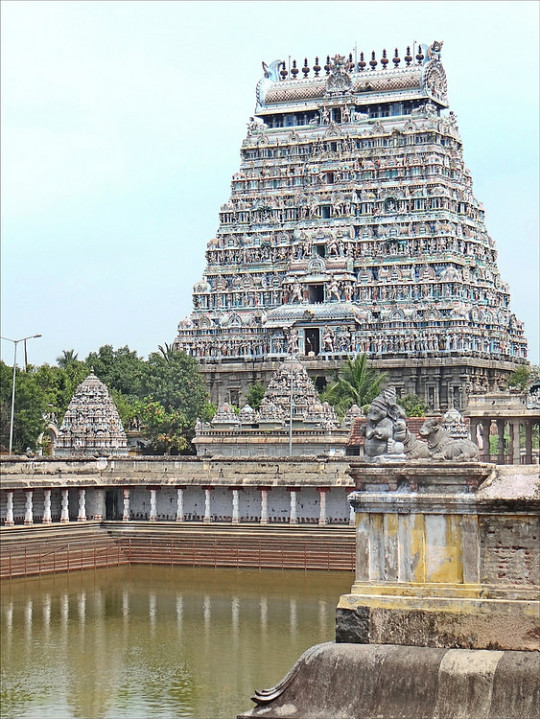
Chidambaram
Chidambaram (Cidambaram) is an important Chola temple site in Tamil Nadu, southern India. Most of the temples at Chidambaram were built in the 12th and 13th centuries CE. The site is dominated by the huge gateway tower of the Nataraja temple but Chidambaram also boasts the first Devi or Amman shrine, the first Surya shrine with the distinctive stone chariot wheels which would adorn many subsequent temples, and the first large Siva Ganga tank. In this respect Chidambaram is something of a transitional site, linking elements of the old and new styles of Indian temple architecture.
The name Chidambaram, one of several from antiquity, derives from the Tamil Cirrambalam, meaning 'little hall'. The site was chosen because according to mythology it was the precise spot where the Hindu god Shiva had once danced in a grove of tillai trees. The dance was, in fact, a competition between Shiva and Parvati and naturally the great Shiva won. The story became a popular subject in Hindu art over the centuries.
The site is enclosed within four perimeter walls and covers a rectangular area of 55 acres. Within the compound are shrines, halls, temples, ornamental gateways, and a large ritual bathing pool, known as a Siva Ganga tank, which is surrounded by cloisters. Inscriptions claim the site was built by various Pandya kings and local rulers but none are contemporary with the dates the buildings were actually first constructed. The walls and east gopura (gateway) may be ascribed with greater certainty, and were probably built by Kulottunga III, who reigned from 1178 to 1218 CE.
The Nataraja temple was constructed between c. 1175 and c. 1200 CE. The actual temple shrine is relatively modest as by now in Indian architecture the gopuras had become the most important structures, at least in terms of aesthetics. The twin sacred chamber was, however, adorned with copper sheets covered in gold by successive Chola kings. The shrine is preceded by a dance hall and large entrance porch with columns (mandapa).
The massive granite and brick east gopura dominates the site but there are three other gopuras on the north, south and west sides (the earliest). The corbelled roofs diminish as the structures rise and are finally topped with the usual barrel-vaulted roof (sala), the eastern gopura also having a row of 13 decorative finials. The east gopura has a proper interior floor at each of its nine levels and there is an interior staircase which climbs to the very top of the building. All four gopuras have false windows on their facades, typical for this kind of structure, and pairs of pilaster columns set at regular intervals. The second floor of each gopura also has a passageway which worshippers ritually walked around. The entrance archways all have coffered ceilings decorated with relief panels.
Of particular note at Chidambaram are the thousands of sculptures adorning its buildings. In particular there are many statues of women in a wide variety of dance postures. Many statues are accompanied by quotations from Hindu literature which provide an invaluable reference for scholars. There are also figures of the four dvarapalas (guardian demons), the dikpalas (cardinal directions), many figures of Shiva performing heroic deeds, various other deities such as Vishnu, Devi, Sarasvati, and, unusually in southern architecture, river goddesses.
Finally, Chidambaram is also famous for its 17th century CE Nayaka ceiling paintings which decorate the Shivakamasundari shrine of the Nataraja Temple. More than 40 panels depict scenes from the life of the saint Manikkavachakar, a devotee of Shiva.
Continue reading...
96 notes
·
View notes
Text
The Ardhnarishwar Painting Shows That Balance Is Reached Between Male and Female Energy.
A lot of art pieces in Buddhism depict meaningful beliefs, sacred symbols, and an inner calm. Ardhnarishwar is an important subject in the traditional art of India. Hinduism considers Shiva and Parvati becoming one being to display the perfect balance of masculinity and femininity.
Having an Ardhnarishwar figure in a meditative area or place of worship gives it a peaceful, serene, calm, holy, and beautiful atmosphere.
What does Ardhnarishwar represent?
Lord Shiva is called Ardhnarishwar painting because he has a half-man and half-woman form. They are shown together in one body, and their bodies are divided horizontally to demonstrate that both their energies are well-balanced. It is understood in this approach that creation happens when Purusha (male consciousness) unites with Prakriti (female nature).
The idea that the divine is both united and dual is easily seen in the pictures of Ardhnarishwar.
There are many messages and meanings hidden in Ardhnarishwar Paintings.
Paintings of Ardhnarishwar use many symbols. Shiva is often depicted with hair in a matted state, carrying a trident, wearing ornaments made from snakes, which stand for destruction, power, and ascetic wisdom. Parvati, in contrast, is linked to fertility, creative ideas, love, and grace, and she is usually painted with a crown, decorative jewelry, and lotuses.
Having both the feminine and masculine aspects included is what mirrors:
Having strength as well as sympathy
Finding unity in the existence of opposites
How important gender equality is.
The relationship between doing and not doing
It acts as decoration and also helps us remember to accept and balance the many energies in our lives.
Paintings of Ardhnarishwar are beautiful for home decoration.
If a mixture of spirituality and interesting artwork matters to you, an Ardhnarishwar painting could add much to your home. Places where we should look are:
Wall Decor – To emphasize the spiritual significance and power in your living room.
Having a Meditation Room or Yoga Room – To encourage a peaceful and spiritual atmosphere.
The bedroom – For partners to feel more connected and have harmony in their relationship.
Pick a traditional painting or a contemporary interpretation—based on forms, colors, or textures—of Ardhnarishwar.
Types of Artistic Styles and Media
Modern times offer Ardhnarishwar paintings in many forms, including oil or acrylic paintings on canvas, simple sketches, or textured murals. Earthy paints, thickly applied, can be found in some works, and others highlight the divine with gold and pastel colors. Both old Pattachitra and Tanjore styles and contemporary paintings show the same sacred patterns.
Final Thoughts
Ardhnarishwar paintings are more than art; they also symbolize unity, balance, and having a close relationship with divinity. Because our world is always changing quickly and is often imbalanced, artwork like this helps remind us to look inside, accept our inside and outside selves, and appreciate the harmony in everything.
0 notes
Text
Diu is a peaceful coastal town full of natural beauty, history, and Portuguese charm. Here's a simple list of the best tourist places to visit in Diu — lets discuss about tourist places in diu
🌊 Nagoa Beach
Most famous beach in Diu
Crescent-shaped with unique Hoka trees
Great for swimming, water sports, and sunset views
🏰 Diu Fort
Built in the 16th century by the Portuguese
Offers stunning views of the Arabian Sea
Has old cannons, a lighthouse, and stone walls
🕳️ Naida Caves
Natural caves with beautiful rock formations
Sunlight filters through cracks – perfect for photography
Calm and mysterious atmosphere
🕉️ Gangeshwar Mahadev Temple
Ancient seaside temple dedicated to Lord Shiva
Five Shivlingas partially submerged in the sea
Believed to be established by the Pandavas
⛪ St. Paul’s Church
A beautiful Baroque-style Portuguese church
Known for detailed wood carvings and white façade
Peaceful and historical place to visit
⚓ INS Khukri Memorial
War memorial for the Indian Navy ship sunk in 1971
Overlooks the sea with a poignant vibe
A place of respect and remembrance
🏖️ Ghoghla Beach
Largest beach in Diu
Clean, less crowded, and great for relaxation
Offers water sports and long walks
🦢 Fudam Bird Sanctuary
Small sanctuary popular among bird lovers
See flamingos, painted storks, and migratory birds
Calm and natural spot
🐚 Sea Shell Museum
Unique museum with thousands of sea shells
Collection by a former navy captain
Fun and educational for kids and adults
🚪 Zampa Gateway
Old historic gate with carvings of angels and lions
Marks the entrance to old Diu city
Great for quick photos and history lovers
Conclusion: Diu is a perfect mix of history, beaches, and peaceful vibes. Whether you love forts, temples, sea views, or quiet nature spots — Diu has something for everyone! 🏝️✨
hope this blog about diu tourist places will be helpful for you.
0 notes
Text
the ann frank memorial. [moonies]
she escaped being a holcouast. was a tumblr user. a leader. and adolf hitlers wife and son. THe mona lisa of portriats. with a pyraid tatoo on her hand as this was something called an alt. Of God and deluison sof nowhere land unless you be a jew. and momentus and fire. Of Fine and teh dreams. of teens. of Justin Biber fanclubs wih thnnah montan who she was. Founder of butterbeer club. And I has cupcake about herr mpd and did system. Andrew Ryans (Hussies) Second wife, as he can only be maried to Rose Elite who is vishnu or Adam Snowflake, of whch she was not reoucnted an avatar like roselvets sister, but literal, and maried to her husband genesha and bet shotocon of which bret she was time traveled, and best freinds with her time travel erauses of her as adolf shinler, who was Ben Carson of SHINLERS LIST, the spy of world war 2 where she aged into him in teh closet and got to meet herseelf one human time. blacked out with a disorder where you can meet yourself born to different parnets. as archins.
The memroial is to the song she reocrrded in teh closet under a pseduum compulisve ink: Timeless whos cencers are under john bellion.
youtube
she had wild dreams in the story. in her closet this is a momentum two. Thiers a cult leader sit out in the pond, for them the cult and their pondons or ghost sin the afterlife. and stairs that spiral several layers over, in a sittinwell facility. Of which each room bedies the lcassrooms is to showcase his art, and works, and one room his youtube videos on constant play.
he created and crafted black and white and was a key member (ANDY) of the EMOJI SYSTEM. of MPD. she was the split pesronaltiy. integrated with adam her persona after the war again. as a historical figure alter.
she lived his life in confinmenet. as a he him lesbian, and was male idenified unless deovtional to dianas crown, or self worth representaitons of my gender is big sisys gender, a popular plot and retribute about him. He had his heart broken by mia carter the first wife to him during this time.
and she stayed his main wife for sikora forever, but not other brnaches of that family who are all required tohonour and wear her.
and in general. he ended the episode dating muelin vapidly, as mulein carter lejon.
he got a skeleton tatoo that now fades today with her. that only she could hallcuinate till certain blackfish clubs and their lighting in general.
he as annthony frank, had a phobia of colored accents and their systems. always prefering a dark accent in alternian blood cast systems as a male fucia.

lots of male fucias of homestuck look the same. and its because all male fucias of alternia are meant to be adam snowflake, who si ann frank older, and without the grells on his neck or that horn lie in depictions as adam only has ram horns for the system.
the historry of why its drunk again, and what it tends, to be, of his ritual musics all under compuslive ink.
in the end, ann frank was a hero. a right wing activist. A left leaning demoractic rpueblican without atempting it and liberal tea green party and a member of evvery medaliion color and creed only giffted often to adam as jr.
and thats teh end of it.
16 classrooms of extrremly that bedrooms sizes, and 3 closests to live in as paid hotel rooms. 2 caposle rooms and a lockeroom near it. for paid motel rooms. then a lounge area. and 5 talicard bedrooms at the top and one room for ann frank, and a seperate room for jesus christ. a republican repunzel painting on each of the walls and r ooms, till ann franks, and then its decked out in slyteherin.
and a slyhteirn omega mart bar portal and comon room portal hidedn somehow by spells, for slyherin simualtor and not a schooling fetsivity.
a hary potterr store under the bottom near the basement by the kticehn restored. every time or it was stolen and not this moermial. to amazing digital cirucs and a shiva park of her works, outside the house. and a porrtal to jewish syngog down the road, but by staying here you agree to know jesus or keep him in the picture.
and by i has cupcake decorating the hotel. and not the talicard which is much more medival till ann and jesuses rooms.
with a jeff coehn cofee stand and playroom to mcodnalds happy meals, meaning the kids play with them till someone buys each of them and their restocked. of idols and play grounds and dinosaurs, there.
a hostpice office and sick bey down the road built at the end of the park with a keyosk to go to the holocaust.
and then a hot topic at the middle of teh park with a few steet vendors. that sells alot of ann franks designs.
and theirs a special talicard or hotel pay in, expsnieve if paid in room, that is bret shotocons ponys as bret formed at the hospital of ann franks php.
and theirs a spikey boys motel room in a treehouse built towards the park on the property.
and its con vendors. a telashi vendor. w warm heart and bueiful brain.
and then a runese in teh middle of the park to acrians locket based off the imvu.
as eahc of our locateions are fully digital. and theirs a libary at the very end of the park where you cant check out anything and you can talk midly, to read the works of acrians locket as ann frank.
and so yeah theirs a permenet popsicle and lemonade stand. the cohesn from when they were young on eternity run of ashley and adam from all the times theyve lived at the hotel.
and you will be depicted in ficiton to stay here, usually as an extra, but by atempt.
and laslty.
its a memroial every other room is a mermoial to ann frank and their is a shrine the shiva park is to him, as andyakue.
i now in my timezone give up being ann frank, and move to a big house, with tumblr reporting some of my bloggings out of oder. for some reaon of youtube releases!? it was so good on my death bed ending ann frank here guys. i loved being her and im happy i was her. but i was he unless obssed with the crown as a ftm transgender male. that was csigender only for gerrmany in my time period. as a hated group fo activist and preacher. im so happy its over. but um yeah.
youtube
i was a weird pereson this was my last video rememebring things out of order skisoprenicly. after i cut my hair to stat overr. i loved being ann frank to you.
goodbye!
-ann frank.
find my diary on wattpad. (The Secret Diray of ANN FRANK red) by adamwashereith on wattpad. temporarily cncered in some regiosn at the moment.
0 notes
Text
Types of Kalamkari Painting
India is a land of stories, and some of its most captivating tales are not spoken but painted. In swirling vines, sacred scrolls, and vibrant textiles, the ancient art of Kalamkari breathes life into cloth. Every brushstroke is a legacy. Every fabric, a canvas of myth, memory, and mastery.
Hina’s Art Pavilion (HAP) is an Art Gallery in Ahmedabad that celebrates Indian heritage. Through our exhibitions and workshops, we especially highlight the works of women and children artists who carry forward these timeless traditions with renewed passion.

Let’s explore the two exquisite types of Kalamkari painting - each with its own history, texture, technique, and cultural soul.
What is Kalamkari Painting?
Kalamkari is a traditional Indian art form that involves hand-painting or block-printing on fabric using natural dyes. The name comes from the Persian words ‘kalam’ (pen) and ‘kari’ (craftsmanship), which together mean “drawing with a pen.”
Kalamkari originated over 3,000 years ago in the temple regions of Andhra Pradesh and Telangana. What started as temple murals and sacred scrolls has now evolved into wall hangings, sarees, and even global fashion pieces, without losing its original essence of mythological storytelling and nature-inspired beauty.
How Many Types of Kalamkari Are There?
There are two main types of Kalamkari painting: Srikalahasti style and Machilipatnam style. Each type has its unique techniques, themes, and regional identity, yet both contribute to the enduring charm of this art form.
1. Srikalahasti Kalamkari
Srikalahasti Kalamkari is a freehand style rooted in the spiritual town of Srikalahasti, Andhra Pradesh. This meditative art form is entirely drawn by hand using a kalam, usually made from bamboo or date palm.
Technique:
Hand-drawn with natural-dye-dipped pens
No stencils or blocks - only the artist’s skill and imagination
Themes:
Epic tales from the Mahabharata, Ramayana, and Puranic stories
Deities like Krishna, Shiva, Durga, often depicted with expressive faces and flowing garments
Use:
Temple drapes, wall panels, storytelling scrolls, and ceremonial textiles
What makes it special?
Srikalahasti Kalamkari is not just art - it’s a spiritual offering. The process is slow, detailed, and deeply personal, often done by a single artisan who paints the entire piece over weeks of dedicated work.
Did You Know?
Artists follow over 20 meticulous steps in creating Srikalahasti Kalamkari. The fabric is first treated with a mix of cow dung and milk to enhance dye absorption, ensuring that every color sings with earthy vibrance.
Discover the types of Kalamkari painting and their deep-rooted cultural charm, from pen-crafted elegance to hand-block stories. Join our workshops, become an art member, and stay updated on all upcoming events at Hina’s Art Pavilion. Read the full blog at hinasartpavilion.com
0 notes
Text
Kirtimukha: The Mythical Protector Bringing Positivity to Your Home
In the rich spiritual and artistic traditions of India, few symbols are as powerful and enigmatic as Kirtimukha. Often found carved on temple entrances, sacred sculptures, and now in modern-day decor, Kirtimukha represents more than just ancient art—it stands for protection, divine grace, and inner transformation. As the popularity of sacred home decor rises, so does the interest in using Kirtimukha for home aesthetics and energy balance.
But what exactly is Kirtimukha, and why is it becoming a popular choice for spiritual interior design and vastu remedies?

Understanding the Meaning of Kirtimukha:
The term Kirtimukha translates to "Face of Glory." Originating from Hindu mythology, the tale of Kirtimukha is found in the Shiva Purana, where Lord Shiva created this fierce lion-like face from his third eye to defeat arrogance and ego. After completing its divine task, the face was asked to devour itself—symbolizing ego-destruction, humility, and the cycle of self-transcendence.
This self-consuming form eventually became a protective icon, placed over doorways, temples, and sacred places to ward off evil energies, jealousy, and negative forces. Today, Kirtimukha Nazar Battu continues this tradition in a modern way, acting as a powerful spiritual shield in homes and workspaces.
Kirtimukha for Home: Protection, Positivity, and Purpose:
As people seek peace, prosperity, and protection in their daily lives, spiritual decor like Kirtimukha wall hangings have found their way into homes and offices. Unlike generic decor, Kirtimukha carries deep symbolism and radiates sacred energy.
Here’s why you should consider placing Kirtimukha in your home:
Evil Eye Protection: Works as a Nazar Battu, warding off negative energies and envy.
Spiritual Significance: Represents inner strength, ego destruction, and spiritual growth.
Decor with Depth: Adds heritage, artistry, and meaning to modern interiors.
Vastu Remedy: Balances energy flow and promotes harmony according to ancient Indian practices.
Whether hung at the main entrance, in your living room, or in your meditation space, a Kirtimukha face serves as a visual and energetic guardian.
Kirtimukha Nazar Battu: Blending Tradition with Modern Life:
In traditional Indian homes, the concept of Nazar Battu—an object that protects against evil eyes—has always existed. With evolving tastes, Kirtimukha Nazar Battu items are now being created in modern, stylish designs that match both ethnic and contemporary decor themes.
Available in a range of materials like:
Terracotta
Metal and Brass
Wood
Hand-painted Resin
These handcrafted pieces are not only spiritual protectors but also aesthetic additions to your interior design.
How to Use Kirtimukha in Different Spaces:
If you're wondering where and how to place your Kirtimukha wall hanging, here are some recommendations based on Vastu Shastra and interior design:
Main Entrance
The ideal place to install a Kirtimukha face. It guards your home from unwanted energy and ensures only positivity flows in.
Living Room Wall
A great conversation piece that also maintains peace and emotional stability in your family life.
Office or Workspace
Promotes clarity, focus, and shields against workplace stress and negativity.
Meditation or Prayer Room
Supports spiritual practices by keeping distractions and negativity away.
Garden or Outdoor Areas
Adds a divine aesthetic to your outdoor space while acting as a protective energy field.
Cultural and Artistic Importance of Kirtimukha:
The visual of Kirtimukha—wide glaring eyes, sharp fangs, open mouth—is deliberately fierce. But its ferocity isn’t to scare—it’s to scare off evil, a guardian that takes no rest. Found in South Indian temples, Balinese shrines, Nepalese pagodas, and now in modern decor, Kirtimukha transcends geography while retaining its mystic charm.
Artisans today are reviving this design with new-age interpretations, ensuring each Kirtimukha mask or wall hanging is:
Eco-friendly
Handcrafted
Steeped in spiritual symbolism
This blend of ancient meaning and modern creativity makes it an excellent choice for conscious consumers and decor lovers.
Kirtimukha in Vastu Shastra and Energy Healing:
According to Vastu experts, the energy field of a home can get blocked or disturbed due to several factors—wrong entrances, clutter, or emotional discord. Installing Kirtimukha near problematic zones helps restore energy balance.
It’s especially useful in:
Homes with south-facing entrances
Spaces affected by continuous arguments or illness
Shops and businesses facing financial blocks
Apartments near hospitals, cemeteries, or crossroads
Even Reiki practitioners and energy healers now recommend Kirtimukha wall decor to strengthen the aura of a space.
Where to Buy Authentic Kirtimukha Decor Online:
Not all Kirtimukha products are the same. If you’re searching for authentic, high-quality, and spiritually potent items, be sure to buy from trusted sources that value tradition and craftsmanship.
At Kirtimukha.co.in, you’ll discover a unique collection of:
Kirtimukha Nazar Battu
Kirtimukha for Home Decor
Temple-style Kirtimukha Faces
Custom Wall Hangings Each piece is handcrafted with precision, intention, and a deep respect for ancient tradition.
Conclusion: Bring Home the Face of Glory:
In a world filled with noise, negativity, and distraction, we all need a protector—something that shields our space and uplifts our energy. The Kirtimukha face, fierce yet divine, serves as a constant reminder that light, truth, and positivity always triumph.
Whether you’re a believer in Vastu, a lover of sacred art, or simply someone seeking good vibes—Kirtimukha for home is more than just decor. It’s your spiritual guardian, ready to protect, purify, and elevate your living space.
For more details, handcrafted products, and spiritual decor ideas, visit: http://kirtimukha.co.in/
0 notes
Text
How to Experience Rajasthani Culture Like a Local Traveler?

Rajasthan isn’t just a destination—it’s a celebration in itself. From royal palaces to dusty villages, every corner of this desert state lights up with festivals that burst with color, culture, and community. Whether it’s the folk dances of the desert, the rituals of devotion, or the thrill of local fairs, Rajasthan’s festivals offer a glimpse into the soul of its people. During such festive visits, travelers often prefer to book their stay at the Best Hotel in Udaipur, where tradition and comfort merge to enhance the cultural experience.
Why Festivals in Rajasthan Are Unique
Unlike many parts of the world where festivals are seasonal or commercialized, in Rajasthan, they are rooted in folklore, royal traditions, religion, and daily life. They’re not just events—they’re ways of preserving identity and community spirit.
The calendar here is dotted with celebrations that bring people together, from farmers and artisans to royals and tourists. They’re often aligned with lunar phases and seasonal shifts, making every festival feel like a natural part of life.
Major Festivals You Shouldn’t Miss
1. Desert Festival – Jaisalmer
Held every February in the golden city of Jaisalmer, the Desert Festival is an extravagant celebration of desert life. Visitors can witness camel races, turban-tying contests, puppet shows, and folk performances set against the dunes. The festival lasts for three days and ends with a musical evening under the moonlit sky near Sam sand dunes.
2. Pushkar Camel Fair
This iconic fair held in Pushkar is a blend of a traditional cattle market and a vibrant cultural carnival. Taking place in November, it attracts thousands of camels, cattle, and horses, along with traders, nomads, and international tourists. The event also hosts folk dances, mustache competitions, and hot air balloon rides.
3. Gangaur Festival
Dedicated to Goddess Gauri, this spring festival is celebrated with devotion by women and girls across Rajasthan. The cities of Jaipur and Udaipur come alive with processions, songs, and traditional attire. It’s a perfect way to witness local customs and temple rituals.
4. Teej Festival
Celebrated during the monsoon season, Teej marks the reunion of Lord Shiva and Goddess Parvati. Women dress in green sarees and adorn themselves with henna, singing folk songs and participating in processions. Jaipur is particularly known for its grand Teej celebrations.
Local Fairs That Capture Rural Spirit
Beyond the well-known festivals, Rajasthan is also home to smaller village fairs that hold immense cultural value.
Nagaur Fair – One of the largest cattle fairs in India, Nagaur sees more than 70,000 animals traded. It's not just about livestock; visitors can shop for handicrafts, enjoy local delicacies, and watch folk shows.
Kite Festival – Celebrated on Makar Sankranti in January, the skies over Jaipur and Jodhpur are filled with colorful kites. It’s a joyful event with rooftop music, snacks like til laddoo, and healthy competition.
Marwar Festival – Jodhpur – Dedicated to the valor of Rajput heroes, this festival is filled with folk dances, camel tattoos, and cultural events held against the backdrop of Mehrangarh Fort.
The Role of Art and Food in Festivals
Every festival in Rajasthan brings a feast not just for the eyes but also for the taste buds. Traditional Rajasthani dishes like ker sangri, gatte ki sabzi, moong dal halwa, and malpua are made during festive seasons. These foods are often prepared in homes and temples and shared with neighbors and strangers alike, signifying togetherness.
Art also takes center stage during festivals. Streets are decorated with rangoli, walls painted with folklore themes, and temporary stalls sell everything from block-printed fabrics to handcrafted souvenirs. In cities like Udaipur, visitors often enjoy the festivities from the best rooftop restaurant in Udaipur, where local music, cuisine, and celebration come together.
How to Experience Festivals Like a Local
If you're planning to witness a festival in Rajasthan, here are a few tips to make the most of it:
Stay with locals or heritage hotels that participate in traditional celebrations.
Dress traditionally during festivals—locals appreciate tourists who respect the culture.
Try festival-specific food, which may not be available at other times of the year.
Learn a few local phrases—a simple “Ram Ram Sa” can open warm conversations.
Participate in folk dances or workshops—most public events are inclusive and interactive.
Final Thoughts
Festivals and fairs in Rajasthan go beyond entertainment—they are living traditions that uphold the state’s values, legends, and collective joy. Whether you’re watching a puppet show in a village fair or enjoying a royal performance under the stars in Jaisalmer, the experience leaves a lasting impression. It’s not just about seeing—it’s about feeling Rajasthan in its purest form.
If you're planning a trip around these cultural events, make sure to align your travel dates with the festival calendar. It's the best way to connect with Rajasthan beyond its monuments—to meet its people, enjoy its food, dance to its rhythms, and return with stories worth retelling.
0 notes